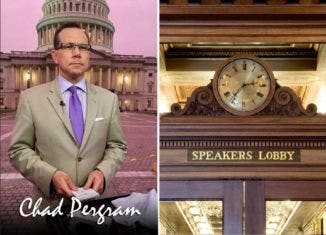Everything Old is New Again
They spoke of an impending economic catastrophe.
From the Richmond Times-Dispatch:
“If Congress cannot meet the deficit requirements, the new law contains an emergency provision that has been likened by several members (of Congress) to a ‘freight train bearing down on every American.’”A Republican Congressman from Ohio characterized the required automatic spending cuts as “arbitrary, mindless and irrational.”
The House Majority Whip was more specific as to what faced lawmakers.
“Congress must achieve the (spending reduction) targets or it sets into place an automatic process where the president has the right to sequester funds,” the whip said. “It sounds great: an automatic Doomsday machine that’s going to do it.”
A former White House budget director warned that indiscriminate cuts “could wreck the economy.” He noted that “deficit reduction by formula…produces absurd and dangerous results.”
Leon Panetta predicted that Congress was “leaping into a black hole and we don’t know where we’re going to land.”
They were all talking about compulsory federal spending abatements which loomed over Washington unless Congress acted.
Everyone in Washington is now fretting about obligatory spending decreases scheduled to hit in January. The government is forced to trim programs because lawmakers haven’t figured out a way to shut off the sequester mechanism. It was instituted as a part of last year’s agreement to hike the debt ceiling. The federal government now finds itself in this position because last year’s bipartisan, bicameral supercommittee failed to forge a deal on a minimum of at least $1.2 trillion in cuts.
And all of the hand-wringing mentioned above wasn’t from present day Washington.
The Richmond Times-Dispatch published that article on December 15, 1985. The Ohio Congressman is former Rep. Willis Gradison (R-OH) who resigned in 1993. The House Majority Whip was Rep. William Gray (D-PA), who left office in 1991. Leon Panetta wasn’t Defense Secretary. At the time, he was a Democratic Congressman from California. And the former Budget Director was Charles Schultze who served under Presidents Kennedy, Johnson and Carter.
As they say, what is past is prologue.
And those who cannot remember the past are condemned to repeat it.
Washington swelled with red ink in the fall of 1985. Deficits mounted. Spending spiraled out of control. And the Treasury Department found itself running short on cash. The Reagan Administration asked Congress to boost the debt ceiling, the statutory threshold governing how much the U.S. can borrow when the books aren’t balanced.
Lawmakers wanted to bring the budget into balance by the early 1990s. So a triumvirate of senators concocted something called Gramm-Rudman-Hollings. Its authors were then-Sens. Phil Gramm (R-TX), Warren Rudman (R-NH) and Fritz Hollings (D-SC).
And they birthed the first sequester.
Gramm-Rudman-Hollings mandated a six-year timetable to balance the budget. It set targets for each year stretching from the mid-1980s until 1991. And if the government failed to find sufficient cuts over that period to balance the budget, a sequester would kick in. It would indiscriminately force massive spending reductions. Everyone shuddered at the thought. That meant that Congress and the administration had to find cuts because no one wanted to meet the wrath of the sequester.
“It’s an amazing chemistry that’s going on here,” said then-Senate Majority Whip Alan Simpson (R-WY) of the experiment to the Washington Post. “We’re like Igor, the mad scientist in his laboratory.”
Simpson added that the effort was “absurd” but conceded the only way to conjure up the votes to raise the debt ceiling was to impose a recipe of extreme fiscal discipline as outlined in Gramm-Rudman-Hollings.
The late-Sen. Daniel Patrick Moynihan (D-NY) declared there was equal pain for all.
“A majority of Democrats agreed to dismantle the domestic policies of Franklin D. Roosevelt in return for a majority of Republicans agreeing to dismantle the defense policies of Ronald Reagan,” said Moynihan.
Accepting such a stark fiscal blueprint – with an enforcement mechanism as blunt as a sequester, was the only way to find the necessary votes to raise the debt limit.
So Senate leaders hitched Gramm-Rudman-Hollings to a bill to increase the debt ceiling on October 9, 1985. Voting for a debt ceiling increase is one of the most-onerous ballots cast by any Member of Congress. But lawmakers can always market a vote to raise the debt ceiling as an effort to find deficit reduction. After all, either Congress was going to balance the budget by 1991 or Gramm-Rudman-Hollings was going to do it for them via the sequester.
The Senate approved the package 74-25.
Engineers who design powerful equipment, nuclear reactors, electrical grids, gas station pumps and even motors for swimming pool pumps always install an emergency shutoff switch. And when it came to a legislative device as crippling as the sequester, Mssrs. Gramm, Rudman and Hollings constructed a shutoff valve in their contraption, too.
“It can be postponed, modified, whatever happens,” said Senate Majority Leader Bob Dole (R-KS) at the time. “If we get up to the crunch, we can always change it.”
+++++++++++++++++++++++++++++++++++++++++++++++++++++++++++++
The nation hurtled toward a potential credit default in the summer of 2011. For most of June and July, Congressional leaders were stymied in efforts to raise the debt ceiling and sidestep a credit rating downgrade. President Obama and House Speaker John Boehner (R-OH) huddled in an effort to forge a “grand bargain,” a deal that would up the debt ceiling but slash trillions of dollars in spending. Those talks failed. Finally, the sides agreed on a plan known as the Budget Control Act (BCA). It raised the debt ceiling but created a supercommittee that was charged with finding trillions of dollars of cuts. However, if the supercommittee failed, the sequester would require automatic cuts in January, 2013.
In other words, the strategy in 2011 was virtually the same as 1985. To court the votes to increase the debt ceiling, leaders needed a rubric to balance the equation with requisite spending cuts. So they installed a sequester (although a rank debate now rages in Washington as to who hatched the idea). But unlike 1985, they also crafted a buffer. That was the supercommittee. That was one of the only major differences between 2011 and 1985 scenarios. And the supercommittee stumbled to broker a pact in November, 2011.
That brings us to where the nation is today, facing a potential calamity in January if the sequester goes into effect. This is part of the so-called “fiscal cliff” nightmare that awaits Washington during the lame duck session of Congress. Can lawmakers contrive an alternative to the sequester during the lame duck? So far, things don’t look good.
But like Sens. Gramm, Rudman and Hollings, the authors of the Budget Control Act also installed an obscure, little understood safety button.
The Supreme Court struck down Gramm-Rudman-Hollings in Bowsher v. Synar. In 1990, Congress and President George H.W. Bush agreed on the Budget Enforcement Act which helped eliminate the budget deficit by 1998. Still, at least one element of Gramm-Rudman-Hollings lived on. When Congress approved the BCA last summer, it repealed sunset provisions of the old law. That breathed new life into the emergency valve originally built in Gramm-Rudman-Hollings. It gave policymakers once last chance to avoid a sequester.
It works like this: The current sequester hits in early January. But once the president orders that sequester, the safety valve grants the majority leaders in both the House and Senate an option to modify the sequester within 20 days. Such a modification resolution is highly privileged in both the House and Senate. Only relevant amendments are in order. Debate is curbed to ten hours and it can’t face a filibuster.
The idea is that once the clock runs out during the lame duck, everyone will have to live with the sequester. Once the president orders the sequester, it becomes a living, breathing animal. House Speaker John Boehner (R-OH) has described the sequester as “ugly.” Writing an Op-Ed in the Wall Street Journal, Phil Gramm noted that his law “never intended across-the-board cuts to be used for anything other than a prod for action and an impetus to force hard decisions lest the dreaded sequester be unleashed on the programs Congress cherished.”
Of course, Congress faces another potential debt ceiling increase this winter. Ratings agencies are already threatening to downgrade to the nation’s creditworthiness. Perhaps a deal in January to secure mindful spending cuts instead of arbitrary ones imposed by a sequester could drum up the votes to avoid that disaster.
That’s the purpose of that last-ditch safety switch resuscitated from a bill passed nearly 30 years ago. It’s kind of like the line in the song “Everything Old is New Again” from Bob Fosse’s film All that Jazz:
“Don’t throw the past away, you might need it some rainy day…When everything old is new again.”
Of course Congress could find another use for the January failsafe toggle – and figure out a way to again kick the fiscal issues down the road.
Which leads us to another line that same Bob Fosse film.
“Let’s go backwards when all else fails.”

